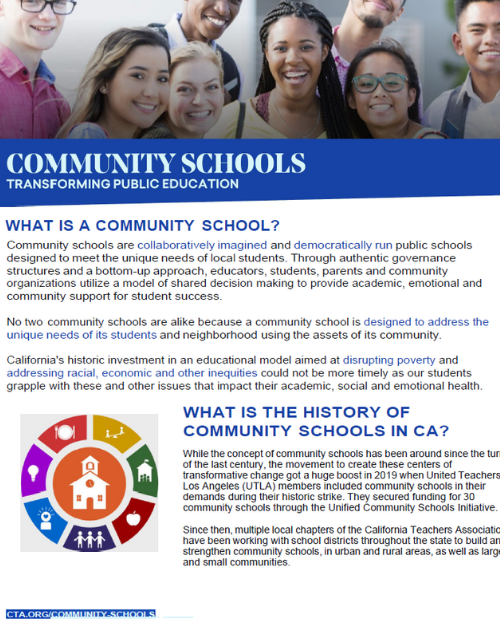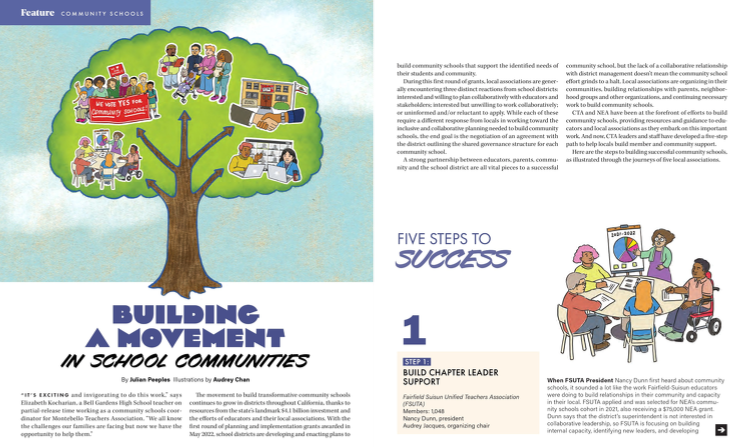What Are Community Schools?
A community school is the heart of a community, uniting diverse and engaged stakeholders in support of the Whole Child. Children are not just taught academics, but learn in environments that make them feel safe, valued, engaged, challenged, healthy and connected. Because they reflect their unique community needs, no two community schools are alike. The shared-governance model of community schools gives all stakeholders (students, families, community members, CTA educators and school administrators) an equal voice in determining how best to serve students.
Community schools provide not only tremendous opportunities for student learning and success, but also offer opportunity and transformation to entire communities. Today, it’s estimated that there are between 8,000 and 10,000 community schools nationwide, and this number continues to grow.
“We’re reimagining schools. It’s so much more than what happens in class.”
Ingrid Villeda, community school coordinator at 93rd Street Academy in South Central Los Angeles
Background of Community Schools in California
The concept of community schools has been around since the turn of the last century. But the movement to create them got a huge boost in 2019 when United Teachers Los Angeles (UTLA) members included community schools in their demands during their historic strike, securing funding for 30 community schools.
Since then, CTA leadership has worked at the statewide level, and multiple CTA chapters have worked at the local level with school districts, communities and partners, to build and strengthen community schools that prioritize student success. Get an overview of CTA members’ key role in these efforts in our editorial coverage here , here , and here.
Benefits of Community Schools
Research shows that community schools help foster:
- Lower rates of absenteeism
- Better work habits, grades, test scores and behaviors
- Higher enrollment in college preparatory classes
- Higher graduation rates
2023 Back-to-School TV and Radio Ads
CTA’s new ad spots highlight the transformative powers of community schools, where students’ and schools’ unique needs are met through a shared decision-making process that involves educators, students, families, and community and school leaders. The result? Improved student learning. Stronger families. Healthier communities.
Check out the new Community Schools ad spots below! And be sure to visit @WeAreCTA on YouTube for more informative Community Schools videos.
“This is why I got into this movement and became a teacher — to make a true difference in a powerful way. Community schools are a chance to do this." - CTA President David B. Goldberg
Tweet This Community Schools’ Pillars of Practice
Community Schools’ Pillars of Practice
The Community School model advanced by NEA includes six pillars of practice. Like most public education models, they are adaptable to the needs of an individual school’s students, staff, families and communities.
Community schools provide a rich and varied academic program, allowing students to acquire both foundational and advanced knowledge and skills in many content areas. Students learn with challenging, culturally relevant materials that address their learning needs and expand their experience. Learning and enrichment activities are provided before and after the regular school day, including sports, the arts, and homework assistance. Parents and families are supported through adult education that is responsive to their emerging needs.
Teachers at community schools are fully licensed, knowledgeable about their content, and skillful in their practice. Instructional time focuses on learning rather than testing. Individual student needs are identified, and learning opportunities are designed to address them. Higher-order thinking skills are at the core of instruction so that all students acquire problem solving, critical thinking, and reasoning skills. Educators work collaboratively to plan lessons, analyze student work, and adjust curriculum as required. Experienced educators work closely with novices, sharing their knowledge and expertise.
The leadership teams of community schools include educators, other school staff, parents, students, and community members. They share the responsibility of school operations with the principal. This leadership team ensures that the community school strategy remains central in the decision-making process. The team plans development and implementation, including thinking about sustainability, such as organizing resources in new and more effective ways.
Community schools emphasize positive relationships and interactions. Restorative discipline practices such as peer mediation, community service and post-conflict resolution help students learn from their mistakes and foster positive, healthy school climates where respect and compassion are core principles. Negative behaviors and truancy are acknowledged and addressed in ways that hold students accountable while showing they are still valued members of the school community. Zero-tolerance practices leading to suspension and expulsion are avoided.
Families, caregivers, and community members are partners in community schools. Their engagement is not related to a specific project or program but is ongoing and extends beyond volunteerism to roles in decision-making, governance, and advocacy.
Community schools recognize that students often come to school with challenges that impact their ability to learn, explore, and develop in the classroom. Because learning does not happen in isolation, community schools provide meals, health care, mental health counseling, and other services before, during, and after school. These wrap-around services are integrated into the fabric of the school. Connections to the community are critically important, so support services and referrals are available for families and other community members. (CRE: April 2019)
The Four Pillars of the California Community Schools Program
The State Board of Education approved the California Community Schools Framework at their January 2022 meeting, which has more details about the Four Pillars and planning and implementation of community schools. As a partner in community schools’ shared decision-making process, CTA is working closely with state agencies and with school districts and other partners and supporters.
The California Community Schools Partnership Program (CCSPP) has adapted the Six Pillars into a community schools model that focuses on Four Pillars:
Integrated student supports, which can support student success by meeting their academic, physical, social-emotional, and mental health needs. Statute defines this as including the “coordination of trauma-informed health, mental health, and social services.” Effectively supporting students also requires that students be well known so that they can be well served.
Family and community engagement, which involves actively tapping the expertise and knowledge of family and community members to serve as true partners in supporting and educating students. Statute defines this as including “home visits, home-school collaboration, [and] culturally responsive community partnerships.” Learning opportunities for family members as well as structures and opportunities for shared leadership are other important elements of authentic family engagement.
Collaborative leadership and practices for educators and administrators that establish a culture of professional learning, collective trust, and shared responsibility for outcomes in a manner that includes students, families, and community members. Statute defines this as including “professional development to transform school culture and climate that centers on pupil learning and supports mental and behavioral health, trauma-informed care, Social Emotional Learning [and] restorative justice.”
Extended learning time and opportunities that include academic support, enrichment, and real-world learning opportunities (e.g., internships, project-based learning). Statute refers to these opportunities as both “extended learning” and “expanded learning” and defines them as including “before and after school care and summer programs.” Expanded learning opportunities can also include tutoring and other learning supports during school hours.
Community Schools: 5 Steps to Success
CTA has developed a detailed five-step path to help locals and leaders build member and community support as you embark on your community school journey. The steps outline the goals and objectives, and ways to achieve them. They include toolkits, reports, news articles and other resources that are periodically updated.
To read how some locals are working to accomplish each step, see our February/March 2023 story that ran in CTA’s Educator magazine.



